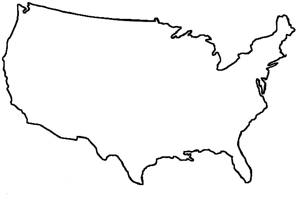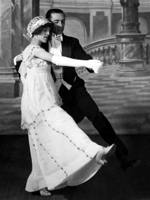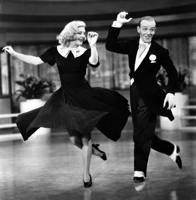
|
The Society of Folk Dance Historians (SFDH)
Choreogeography:
[
Home |
About |
Encyclopedia | CLICK AN IMAGE TO ENLARGE |

|
 In the midst of our fascination with the folk dances of Europe, Mexico, and elswehere, we have committed the error of neglecting our own folk dance traditions. The kolos, horos, verbunks, învîrtitas, and zapateados of romantic, far-away "colorful ethnic natives" evoked far more interesting images than the snobby waltzs of our upper classes or the undignified dances of the lower ones.
In the midst of our fascination with the folk dances of Europe, Mexico, and elswehere, we have committed the error of neglecting our own folk dance traditions. The kolos, horos, verbunks, învîrtitas, and zapateados of romantic, far-away "colorful ethnic natives" evoked far more interesting images than the snobby waltzs of our upper classes or the undignified dances of the lower ones.
Richard Powers has received just fame and praise for changing this attitude, awaking the folk dance community to the richness and validity of our Western European / American dance traditions. There have been several dance revivals this century, most notably by Henry Ford / Benjamin Lovett and later by Lloyd Shaw, both of whom were familiar with the old dance manuals. Several other dance historians have been doing serious research on 19th Century and ragtime era social dance over the past two decades, including Los Angeles' Desmond Strobel, who began holding pulblic balls through his Antique Academy of Genteel Dance.
For those who are unaware of the evolution of American dance, perhaps a review would be in order. For much of the 19th Century, the country was in the process of building a society and a country without precedent. Drawing on the principles of the 18th Century that gave birth to the new country, the nation focused on such things as settling the frontier and the industrial revolution.
Nineteenth Century American society retained the image of its European counterpart, with an aristocracy of industrial barons, a small merchant class, and a large peasant class, complete with 12-hour work days, 6-day work weeks, child labor, and abject poverty. Not surprisingly, the dances of the period paralleled its European origin, including the minuet, the waltz, and the polka, all performed in a style reminiscent of 18th Century Europe.
The 20th Century brought a new life to America. Teddy Roosevelt became the common man's president, effectively putting an end to the industrial barons' control over the lives of the rest of the people. Anti-trust suits, child labor laws, women's suffrage, and governmental regulation combined to allow the creation and rise of the middle class. The frontier was gone, the nation stretched 'from sea to shining sea', and the country began to realize its own identity. Roosevelt's Great White Fleet carried the American Flag around the world, the Panama Canal was built, and Americans began to move in a new direction. With that direction came a growing dissatisfaction with the old dances hanging on from centuries past.

 The newly created middle class was in a dilemma. Though uninterested in the staid dances of their parents, the only other dances around were the vulgar antics of the lower class White society and the untouchable Black communities. We may be amused at their plight, but the situation was ripe for the arrival of Vernon and Irene Castle, just as our society was ready for the arrival of Country / Western Dance in the early 1980s.
The newly created middle class was in a dilemma. Though uninterested in the staid dances of their parents, the only other dances around were the vulgar antics of the lower class White society and the untouchable Black communities. We may be amused at their plight, but the situation was ripe for the arrival of Vernon and Irene Castle, just as our society was ready for the arrival of Country / Western Dance in the early 1980s.
Without recounting the oft-told story of the Castles, it is sufficient to note that their versions of the popular dances of the day perfectly suited the needs of society at that time. The One-Step, Castle Walk, and other dances of the period seem quaint, even archaic, now. At the time, they had the qualities of grace, newness, and danceability. Also, they were in tune with the jazz music of the time, suddenly recognized as legitimate music after years of belonging only to the despised lower classes. The resulting dance frenzy has never been equalled. America began dancing in ernest, and the evolution of 20th Century American ballroom / social / folk dance was underway
Though not drawing directly from Richard Powers' reserch in its "Ragtime to Swing" suite, the Orange County, California performing group Dunaj chose to be guided by the principle of following the evolution of American ballroom dance. In defining the period we casually refer to as "vintage," the group decided to adopt the time period described by those innvolved in vintage clothing – the turn of the century up to World War II. Thus, 1910 to 1940-ish, and the concept of "Ragtime to Swing."
It is interesting to correlate the dances used in the suite (One-Step, Maxixe, Charleston, Lindy Hop, Shag, and Swing) to the social situation of their time. Opening with the One-Step / Castle Walk, the group established a beginning as created by the Castles. The Maxixe was chosen simply for its charm and to demonstrate the variety of dance forms introduced at the time.
The Charleston is still familiar to most of us, with its unmistakable energetic style. The speed with which it appeared and became fashionable is indicative of the speed with which society was changing. The young generation, unbridled by 19th Century dance remnants as were their One-Stepping parents, quickly adopted the Charleston from the antics of the Black community whose members had been dancing it since the turn of the century. The maturing jazz music of the day became their "sound," just as rock 'n roll did for the young generation 30 years later. The Roaring 20s was a time of actively shaking off the past. New ways of thinking were being explored and new energy was being created as the middle class grew in strength and numbers. The Charleston perfectly defined that energy and attitude.
As was so often the case, the Black community was far ahead of proper society in dance innovation. Tiring of the Charleston around the time that it became socially acceptable by the White community, the Blacks moved on to the Lindy Hop. The next step in social dance evolution, though still moving to the popular jazz beat of the '20s, this dance was more earthy than even the Charleston, highly energetic, giving the dancer more opportunity to display his or her dazzling technique.
The 1930s brought the Depression that nearly destroyed the society that had been built in the previous 30 years. Dogged determination replaced freewheeling energy. Dance marathons became popular as people sought distraction from their unhappy lives. The Shag replaced the Lindy Hop in popularity, exchanging the free energy of the Hop for an earthier, even higher energy level.
Finally, the dance most familirar to most of us – the Swing. For many of us, it was the dance of our youth. With the events of World War II, Americans finally realized, having pulled out of the Depression and battling two mighty foes, that we were the strongest nation in the world. The Swing that followed those experiences tapped an unlimited imagination and used a powerful technique. Women, bolstered by their first-time participation in a war effort, became equal partners in the dance, contributing their own energy and skill to create exciting lifts and breath-taking acrobatic stunts. To many, all other forms of the Swing represent a deterioration of the original 1940s Swing.
The application of the principles of dance ethnology to our own dance reveals some interesting and satisfying results. Dance does, indeed, reflect social attitudes, values, and traditions. It tells us, if we can only learn to see and hear, all about those who perform it. Perhaps some day, when the dances of the '60s, '70s, and '80s are considered "vintage," someone will attempt to make those same comparisons.
DOCUMENTS
- Ragtime Dance History, an article.
- Richard Duree, an article.
Used with permission of the author.
This page © 2018 by Ron Houston.
Please do not copy any part of this page without including this copyright notice.
Please do not copy small portions out of context.
Please do not copy large portions without permission from Ron Houston.